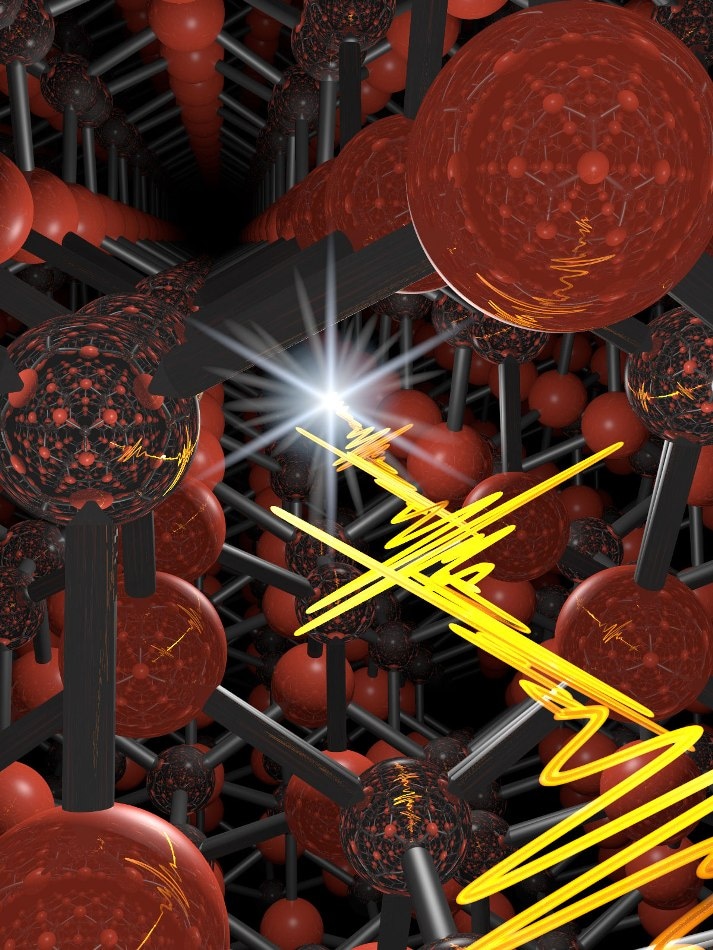Mar 14 2017
 A semiconductor crystal has shown an unprecedented capacity to shape ultrashort laser pulses. CREDIT: Fabian Langer, Regensburg University.
A semiconductor crystal has shown an unprecedented capacity to shape ultrashort laser pulses. CREDIT: Fabian Langer, Regensburg University.
An international research team has created configurable and extremely short “femtosecond” light pulses which can enable the future computers to operate nearly 100,000 times faster than the present ones.
The team, comprising of engineers from the University of Michigan, demonstrated that the peaks within the laser pulses can be controlled and that the light can also be twisted.
The technique has the ability to move electrons in a faster and more efficient way when compared to electrical currents, as well as with reliable impact to their quantum states.
Mackillo Kira, professor of electrical engineering and computer science at the University of Michigan who was a part of the research, stated that the research takes us one step close to the so-called “lightwave electronics,” and also close to quantum computing apparently in the remote future.
Generally, in a computer, the electrons moving through a semiconductor sometimes collide with other electrons, releasing energy in the form of heat. However, the concept of lightwave electronics suggests that electrons can be guided by means of ultrafast laser pulses.
In contrast to a car traveling at high speed that has every chance of crashing into something, the travel time of an electron traveling at high speed can become so short that it is statistically not likely to collide with anything.
In the past few years, we and other groups have found that the oscillating electric field of ultrashort laser pulses can actually move electrons back and forth in solids. Everybody was immediately excited because one may be able to exploit this principle to build future computers that work at unprecedented clock rates - 10 to a hundred thousand times faster than state-of-the-art electronics.
Rupert Huber, Professor of Physics, University of Regensburg
But first, the research team must be able to control the electrons in a semiconductor. This research takes us a step closer to this potential using terahertz radiation to mobilize groups of electrons inside a semiconductor crystal. The terahertz radiation falls between microwaves and infrared light in the electromagnetic spectrum.
The research team irradiated a semiconductor gallium selenide crystal with very short laser pulses of less than 100 femtoseconds, that is, 100 quadrillionths of a second. Each of the pulses excited the electrons inside the semiconductor to a higher energy level, meaning that the electrons were now free to move around, and carried them onward.
The varied orientations of the crystal corresponding to the light pulses indicated that the electrons were free to move in different directions through the crystal. For example, the electrons were able to run along or in between the atomic bonds.
The different energy landscapes can be viewed as a flat and straight street for electrons in one crystal direction, but for others, it may look more like an inclined plane to the side. This means that the electrons may no longer move in the direction of the laser field but perform their own motion dictated by the microscopic environment.
Fabian Langer, Doctoral Student, University of Regensburg
The different journeys of the electrons were reflected in the light pulses as the electrons emitted light when they came to a lower energy level from the higher energy level. The light pulses emitted by the electrons were much shorter than the electromagnetic radiation passed into the crystal, and the bursts of light remained only for a few femtoseconds long.
When the light pulses are passed into a crystal, they rapidly take snapshots of other electrons while they move between the atoms, and they can also be used to read and write information to electrons. In order to achieve this, the research team should be able to control the pulses, and the crystal provides a broad array of tools.
“There are fast oscillations like fingers within a pulse. We can move the position of the fingers really easily by turning the crystal,” stated Kira, whose team carried out research along with scientists from the University of Marburg, Germany, to elucidate Huber’s experiment.
Based on its orientation with respect to the incoming laser pulses, the crystal can even twist the outgoing light waves.
The high speed of the femtosecond pulses renders them able to intercept an electron between its excited state and the state at which it comes down from the excited state, thus enabling these pulses to be potentially used for quantum computations using excited-state electrons as qubits.
“For example, here we managed to launch one electron simultaneously via two excitation pathways, which is not classically possible. That is the quantum world. In the quantum world, weird things happen,” stated Kira.
The small size of an electron renders it to behave like a particle and also like a wave. In an excited state, the wavelength of the electron gets altered. Since the electron existed in two excited states at the same time, the two waves interfere with each other and leave a fingerprint in the femtosecond pulse emitted by the electron.
This genuine quantum effect could be seen in the femtosecond pulses as new, controllable, oscillation frequencies and directions. This is of course fundamental physics. With the same ideas you might optimize chemical reactions. You might get new ways of storing information or transmitting information securely through quantum cryptography.
Mackillo Kira, Professor of Electrical Engineering and Computer Science, University of Michigan
Huber has specific interest in using stroboscopic slow motion cameras to uncover certain superfast natural processes, for example, movement of electrons within atoms.
“Our crystalline solids make for fantastic light sources in this field—with unprecedented possibilities for pulse shaping,” stated Huber.
The research has been reported in a paper titled “Symmetry-controlled temporal structure of high-harmonic carrier fields from a bulk crystal,” to be published in the journal Nature Photonics. The European Research Council and the German Research Foundation have funded the study.